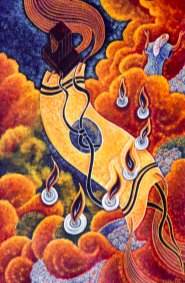By Rabbi Moshe Goodman, Kollel Ohr Shlomo, Hebron
בס”ד
לשכנו תדרשו

This parsha contains the Shema, the Ten Commandments, and many other basic passages of Jewish faith that discuss the fear of God and the abidance to the mitzvot He has commanded us. The talis and tefilin are well-known signs of Jewish faith, and indeed they are mentioned in our recitation of Shema which includes the Shema of this parsha and the parsha of tzitzit associated with the remembrance of all the mitzvot to keep them, as discussed numerous times in this parsha.
We see smoke as it was in the giving of the Torah, and the talis threads resemble smoke here – both matters are indeed reminders about the mitzvot received at Sinai in this parsha. Sinai was first seen by Moshe in the vision of the fire and that seems the significance of strange black fires here that resemble tefilin the symbol of the Exodus as Hashem told Moshe that after the Exodus they shall serve Hashem on this Mount Sinai. Ultimately the purpose of the Exodus and Giving of Torah is to keep them in the Holy Land, and this may be the reason we see houses, representing settlement in the Land of Israel, in the background.
We see Seven candles, similar to the Menora and also the favorite number in the Torah and in Nachshon’s paintings. The fires of these candles seem to correspond to the Kabbalistic worlds as the Gra teaches and it seems for this that the fuel is painted as white corresponding to Keter, Blue is Hochma, red is Bina, yellow is tiferet, black is malchut. Thus, the man at the top of the painting, dressed in white and blue, may correspond to Keter Hochma.
Hebron, City of the Patriarchs, with whom a covenant was formed with Hashem, is therefore also a city that stands for the covenant of our People with Hashem, as is seen through our devoted connection to Torah and the mitzvot and also more externally in our talis and tefilin.



